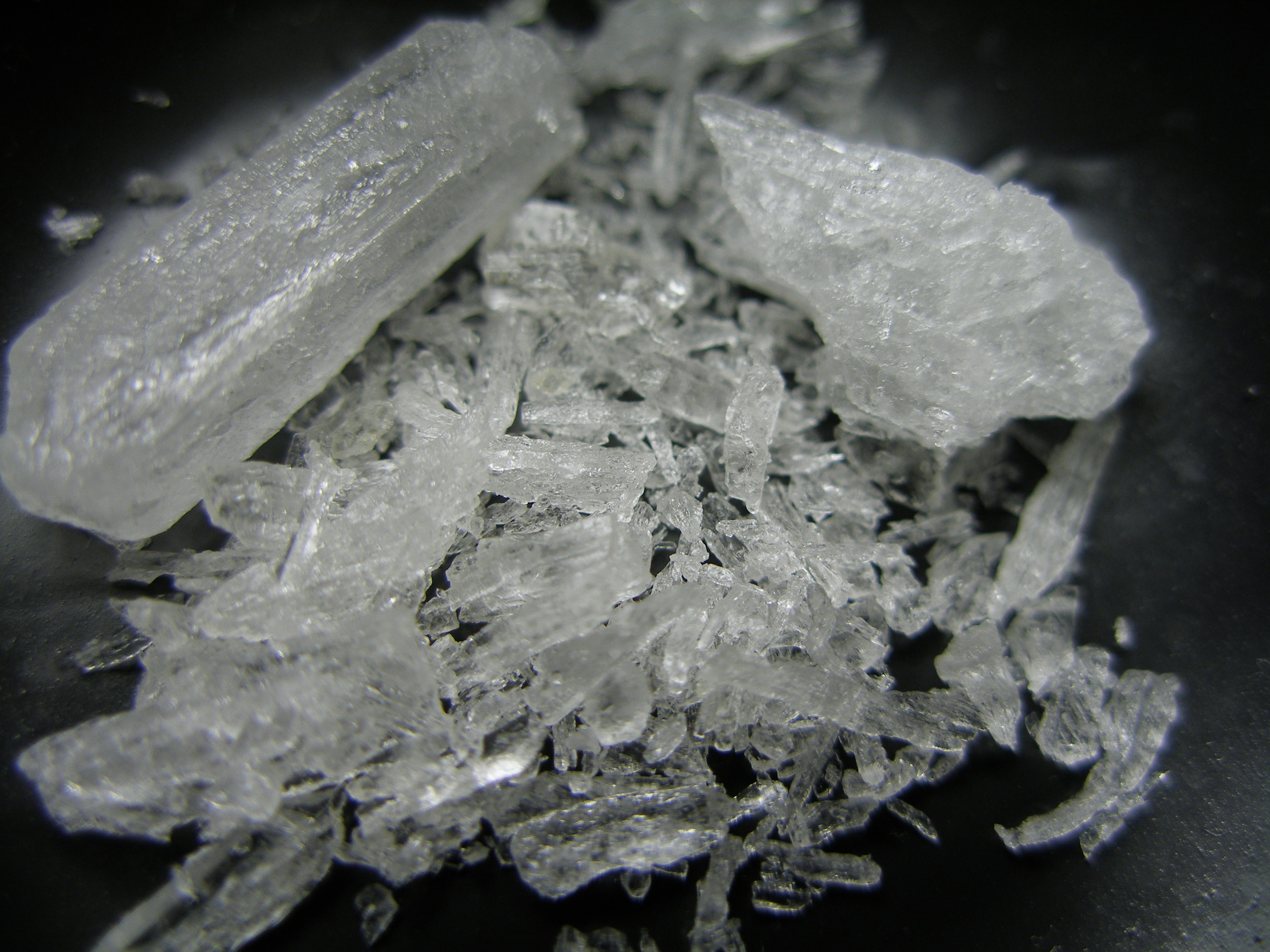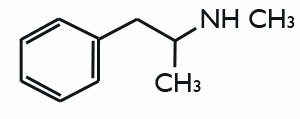Methamphetamine

Methamphetamine is a strong physical and mental stimulant. It is legally prescribed as a treatment for ADD under the brand name Desoxyn, for both children and adults. Recreationally, methamphetamine is used to increase sexual, lift the mood, and increase energy, allowing some users to engage in sexual activity continuously for several days straight. Methamphetamine production is a relatively simple process, especially when compared to many other recreational drugs which has contributed to its widespread use. It is frequently reported on in the media when home meth-producing labs are busted.
Methamphetamine exists as two enantiomers, dextrorotary and levorotary. Dextromethamphetamine is a stronger central nervous system(CNS) stimulant than levomethamphetamine; however, both are addictive and produce the same toxicity symptoms at high doses. Methamphetamine may be sold illegally, either as pure dextromethamphetamine or in an equal parts mixture of the right and left handed molecules (i.e., 50% levomethamphetamine and 50% dextromethamphetamine). Both dextromethamphetamine and racemic methamphetamine are schedule II controlled substances in the United States. Similarly, the production, distribution, sale, and possession of methamphetamine is restricted or illegal in many other countries due to its placement in schedule II of the United Nations Convention on Psychotropic Substancestreaty. In contrast, levomethamphetamine is an over-the-counter drug in the United States.
History
Amphetamine, discovered before methamphetamine, was first synthesized in 1887 in Germany by Romanian chemist Lazăr Edeleanu who named it phenylisopropylamine. Shortly after, methamphetamine was synthesized from ephedrine in 1893 by Japanesechemist Nagai Nagayoshi. Three decades later, in 1919, methamphetamine hydrochloride was synthesized by pharmacologist Akira Ogata via reduction of ephedrine using red phosphorus and iodine. During World War II, methamphetamine was used extensively by the Axis forces for its stimulant effects. Obetrol, patented by Obetrol Pharmaceuticals in the 1950s and indicated for treatment of obesity, was one of the first brands of pharmaceutical methamphetamine products. Due to the psychological and stimulant effects of methamphetamine, Obetrol became a popular diet pill in America in the 1950s and 1960s. Eventually, as the addictive properties of the drug became known, governments began to strictly regulate the production and distribution of methamphetamine. For example, during the early 1970s in the United States, methamphetamine became a schedule II controlled substance under the Controlled Substances Act. Currently, methamphetamine is sold under the trade name Desoxyn, trademarked by the Danish pharmaceutical company Lundbeck. As of January 2013, the Desoxyn trademark had been sold to Italian pharmaceutical company Recordati.
Dosage
| Light | 5-15mg |
| Common | 10-30mg |
| Strong | 20-60mg |
| Heavy | 40-150mg+ |
| Light | 5-15mg |
| Common | 10-40mg |
| Strong | 30-60mg |
| Heavy | 50mg+ |
| Light | 5-10mg |
| Common | 10-20mg |
| Strong | 30-60mg |
| Heavy | 50mg+ |
| Light | 5-10mg |
| Common | 10-40mg |
| Strong | 30-60mg |
| Heavy | 50-100mg |
Duration
These durations are for users of somewhat moderate tolerance. Amphetamine naive users may not be able to sleep for 18+ hours after oral use and other routes will be lengthened as well.
| Onset | 20-70 minutes |
| Total | 8~10 hours |
| Onset | 5-10 minutes |
| Total | 2-4 hours |
| Onset | 0-2 minutes |
| Total | 1~4 hours |
| Onset | 0-2 minutes |
| Total | 4-8 hours |
Effects
Positive
- Increased energy, alertness
- Sleep suppression
- Increased sociability
- Mood elevation
- Increased libido
Neutral
- Excessive talking
- Decreased appetite
- Sweating
- Dilated pupils
Negative
- Weight loss
- Disturbed sleep patterns, Insomnia
- Bruxia
- Drying of oral mucosa
- Loss of appetite
- Visual and auditory hallucinations
- Itchiness
- Aggressiveness
- Moodiness, Irritability, Anxiety
- Increased heart rate, Irregular heart rhythm
- Excessive sweating, Dehydration
- Fatal kidney disorder
- Possible brain damage
- Liver damage
Harm Reduction
When dealing with methamphetamine it's important to remember that a large number of the harms come not from the drug itself, but from the behaviors the drug causes individuals to exhibit. Loss of sleep, poor nutrition, and poor self care are the cause of many of the negative effects.
- Methamphetamine lasts for a long time and will impair sleep. Dose early in the day and do not redose to avoid sleep disruption.
- Oral roa has less redose compulsion than other routes such as vaporization.
- It is important to eat and stay hydrated, even if you do not feel the need for food. Even if you are not feeling like eating you can generally have some fruit or a bowl of cereal or yogurt with granola.
- It is important to keep up on your self-care. "Meth mouth" is caused by poor oral hygiene combined with the habit of users to sip sugary beverages to relieve dry mouth symptoms. Use water and not soda to relieve dry mouth. Remember to brush your teeth after eating or consuming any caloric beverages.
Chemistry and Pharmacology

Systematic name: N-methyl-1-phenylpropan-2-amine
At room temperature, the free base of methamphetamine is a clear and colorless liquid with an odor characteristic of geranium leaves. It is soluble in diethyl ether and ethanol as well as miscible with chloroform. In contrast, the methampetamine hydrochloride salt is odorless with a bitter taste. It has a melting point between 170 to 175 °C (338 to 347 °F) and, at room temperature, occurs as white crystals or a white crystalline powder. The hydrochloride salt is also freely soluble in alcohol and water.
Powder methamphetamine is the hydrochloride salt form which is strongly hygroscopic (absorbs water from the air quickly). The HCl salt is smokable as is. Crystal meth "Crystal Meth" or "Ice" refer to methamphetamine grown into crystals. Though many people believe that Crystal Meth is the freebase form of methamphetamie HCl, this is not true. Methamphetamine is smokable in its normal HCL form, but taking the time to grow it into crystals makes it easier to smoke. Meth in visible crystals (rather than powder) is likely to be relatively pure as it is difficult to grow crystals from impure material. Methamphetamine freebase is an oil and is uncommon on the street.